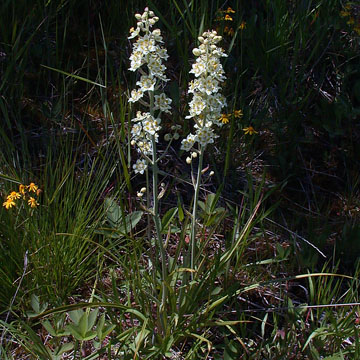

Anticlea elegans - (image 1 of 6)
Taxonomy
Family: Melanthiaceae
Synonymous with Zigadenus elegans Pursh.
Habitat
Calcareous fens, beaches, alvars.
Associates
Distribution
Quebec to NY, west across northern U.S. and adjacent Canada to the cordilleran region from AK to northern Mexico; disjunct in the southern Appalachian region from VA to NC and in the Ozarks of MO and AR.
Morphology
Herbaceous perennial from a tunicated bulb; stems erect 20-60 cm; leaves glaucous, especially when young, mostly crowded toward the base, linear, 20-40 cm, up to 1.2 cm wide; inflorescence 10-30 cm, paniculate (rarely merely racemose), the branches subtended by large, lance-ovate bracts; bracts usually suffused with purple and marcescent at anthesis; tepals 7-12 mm, oblong-obovate, rounded-obtuse, adnate at the base to the base of the ovary, white or greenish-yellow, usually strongly suffused with purple or brown toward the base abaxially, and with a dark obcordate gland just below the middle adaxially; fruit ovoid, 1-1.5 cm; seeds angular, 3 mm.
Notes
Flowers July to August
Wetland indicator: FACW
Typical A. elegans is mostly western, with more yellow flowers, less glaucous herbage, and the inflorescence often merely racemose. The plants shown and described here are var. glaucus (Nutt.) Zomlefer & Judd.
References
Gleason, Henry A.
and A. Cronquist. 1991. Manual of Vascular Plants of Northeastern United States
and Adjacent Canada. Second Ed.
The New York Botanical Garden. Bronx, NY
|
© Michael Hough 2018 |